Mental Health in Australia: Ethical Issues in Public Health
VerifiedAdded on 2022/10/11
|8
|1767
|12
Report
AI Summary
This report provides a comprehensive overview of mental health advocacy in Australia, addressing key areas such as stakeholder engagement, community empowerment, media advocacy, and ethical considerations. It examines the roles of various stakeholders, including family groups, advocacy organizations, and government agencies, in shaping mental illness policies and legislation. The report explores strategies for building coalitions, engaging communities, and utilizing media to raise awareness and improve access to mental health services. Furthermore, it delves into the ethical issues associated with health promotion and public engagement, emphasizing the importance of informed consent and adherence to ethical frameworks. The analysis includes a discussion of how to implement these strategies effectively, ensuring the protection of individuals' rights and promoting positive outcomes in mental health care. This report is a valuable resource for understanding the complexities of mental health advocacy in Australia and is available on Desklib.
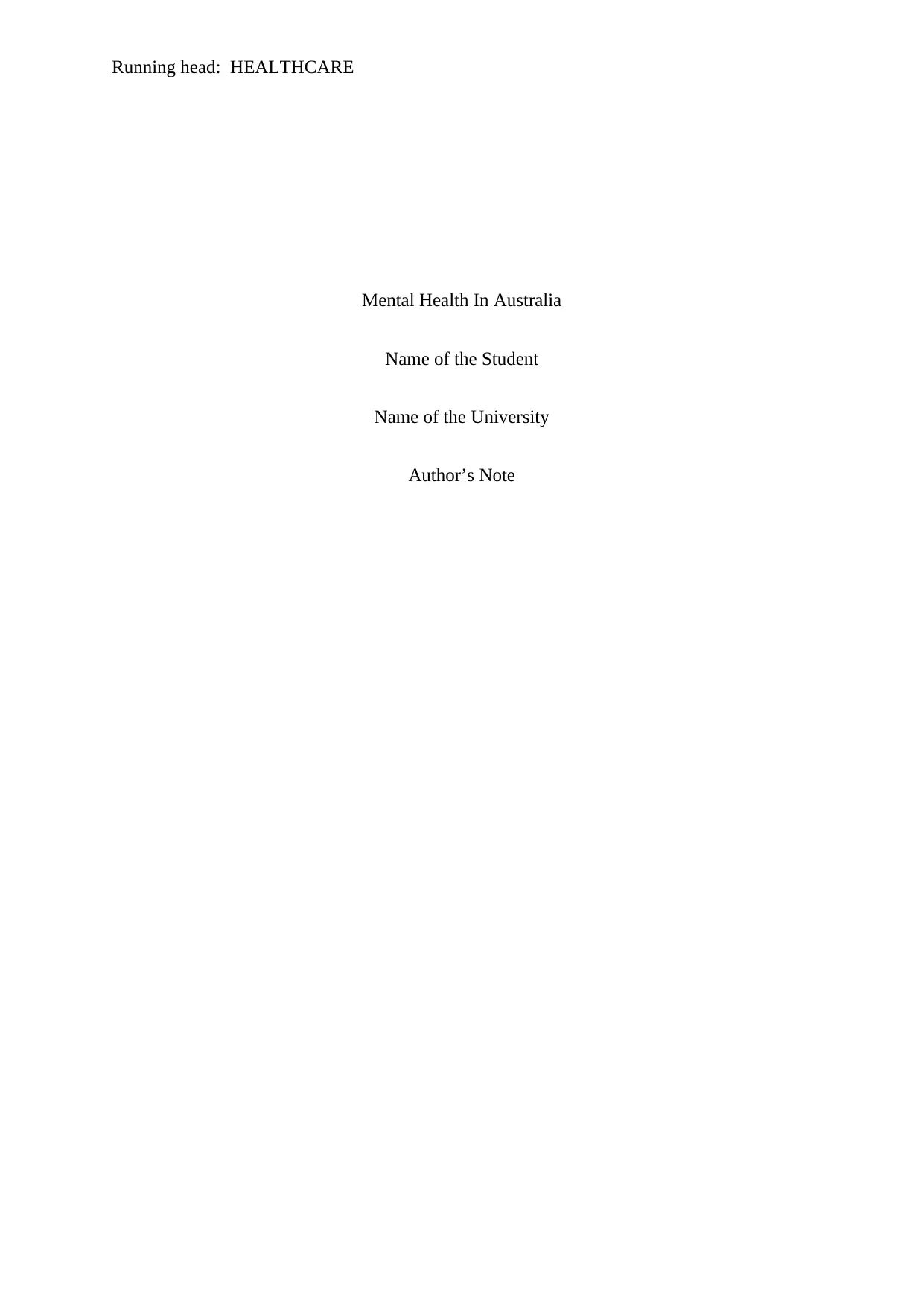
Running head: HEALTHCARE
Mental Health In Australia
Name of the Student
Name of the University
Author’s Note
Mental Health In Australia
Name of the Student
Name of the University
Author’s Note
Paraphrase This Document
Need a fresh take? Get an instant paraphrase of this document with our AI Paraphraser
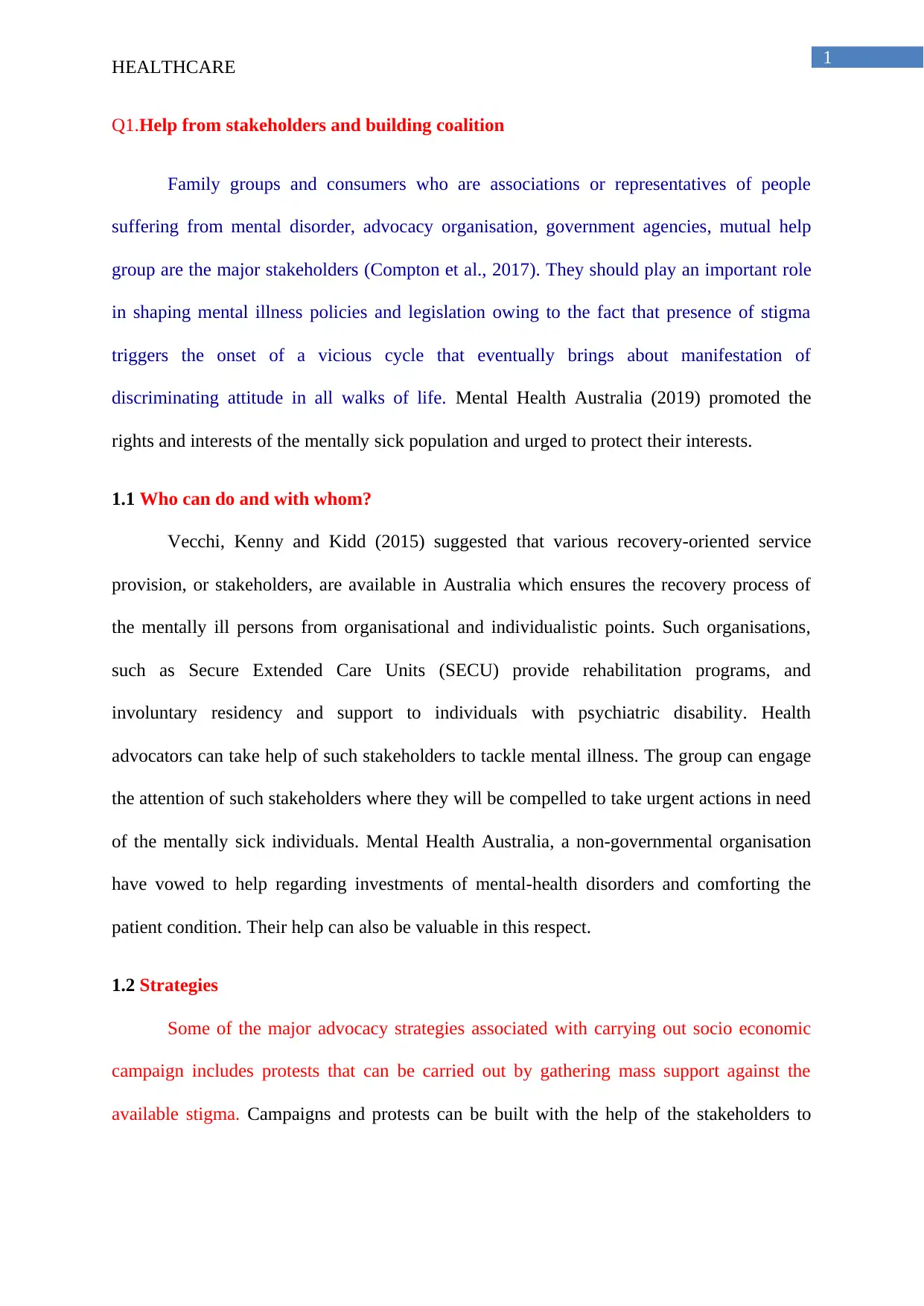
1
HEALTHCARE
Q1.Help from stakeholders and building coalition
Family groups and consumers who are associations or representatives of people
suffering from mental disorder, advocacy organisation, government agencies, mutual help
group are the major stakeholders (Compton et al., 2017). They should play an important role
in shaping mental illness policies and legislation owing to the fact that presence of stigma
triggers the onset of a vicious cycle that eventually brings about manifestation of
discriminating attitude in all walks of life. Mental Health Australia (2019) promoted the
rights and interests of the mentally sick population and urged to protect their interests.
1.1 Who can do and with whom?
Vecchi, Kenny and Kidd (2015) suggested that various recovery-oriented service
provision, or stakeholders, are available in Australia which ensures the recovery process of
the mentally ill persons from organisational and individualistic points. Such organisations,
such as Secure Extended Care Units (SECU) provide rehabilitation programs, and
involuntary residency and support to individuals with psychiatric disability. Health
advocators can take help of such stakeholders to tackle mental illness. The group can engage
the attention of such stakeholders where they will be compelled to take urgent actions in need
of the mentally sick individuals. Mental Health Australia, a non-governmental organisation
have vowed to help regarding investments of mental-health disorders and comforting the
patient condition. Their help can also be valuable in this respect.
1.2 Strategies
Some of the major advocacy strategies associated with carrying out socio economic
campaign includes protests that can be carried out by gathering mass support against the
available stigma. Campaigns and protests can be built with the help of the stakeholders to
HEALTHCARE
Q1.Help from stakeholders and building coalition
Family groups and consumers who are associations or representatives of people
suffering from mental disorder, advocacy organisation, government agencies, mutual help
group are the major stakeholders (Compton et al., 2017). They should play an important role
in shaping mental illness policies and legislation owing to the fact that presence of stigma
triggers the onset of a vicious cycle that eventually brings about manifestation of
discriminating attitude in all walks of life. Mental Health Australia (2019) promoted the
rights and interests of the mentally sick population and urged to protect their interests.
1.1 Who can do and with whom?
Vecchi, Kenny and Kidd (2015) suggested that various recovery-oriented service
provision, or stakeholders, are available in Australia which ensures the recovery process of
the mentally ill persons from organisational and individualistic points. Such organisations,
such as Secure Extended Care Units (SECU) provide rehabilitation programs, and
involuntary residency and support to individuals with psychiatric disability. Health
advocators can take help of such stakeholders to tackle mental illness. The group can engage
the attention of such stakeholders where they will be compelled to take urgent actions in need
of the mentally sick individuals. Mental Health Australia, a non-governmental organisation
have vowed to help regarding investments of mental-health disorders and comforting the
patient condition. Their help can also be valuable in this respect.
1.2 Strategies
Some of the major advocacy strategies associated with carrying out socio economic
campaign includes protests that can be carried out by gathering mass support against the
available stigma. Campaigns and protests can be built with the help of the stakeholders to
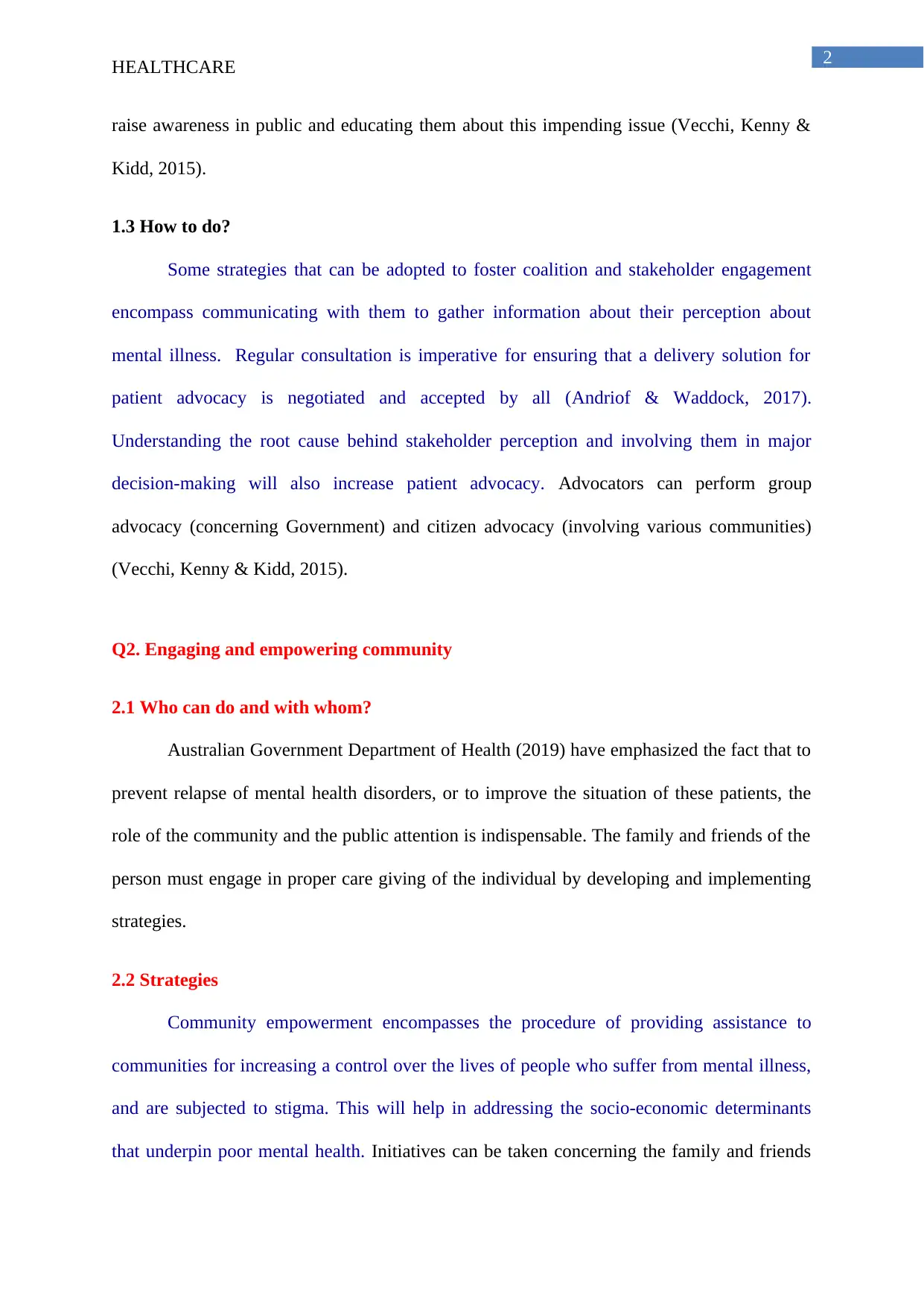
2
HEALTHCARE
raise awareness in public and educating them about this impending issue (Vecchi, Kenny &
Kidd, 2015).
1.3 How to do?
Some strategies that can be adopted to foster coalition and stakeholder engagement
encompass communicating with them to gather information about their perception about
mental illness. Regular consultation is imperative for ensuring that a delivery solution for
patient advocacy is negotiated and accepted by all (Andriof & Waddock, 2017).
Understanding the root cause behind stakeholder perception and involving them in major
decision-making will also increase patient advocacy. Advocators can perform group
advocacy (concerning Government) and citizen advocacy (involving various communities)
(Vecchi, Kenny & Kidd, 2015).
Q2. Engaging and empowering community
2.1 Who can do and with whom?
Australian Government Department of Health (2019) have emphasized the fact that to
prevent relapse of mental health disorders, or to improve the situation of these patients, the
role of the community and the public attention is indispensable. The family and friends of the
person must engage in proper care giving of the individual by developing and implementing
strategies.
2.2 Strategies
Community empowerment encompasses the procedure of providing assistance to
communities for increasing a control over the lives of people who suffer from mental illness,
and are subjected to stigma. This will help in addressing the socio-economic determinants
that underpin poor mental health. Initiatives can be taken concerning the family and friends
HEALTHCARE
raise awareness in public and educating them about this impending issue (Vecchi, Kenny &
Kidd, 2015).
1.3 How to do?
Some strategies that can be adopted to foster coalition and stakeholder engagement
encompass communicating with them to gather information about their perception about
mental illness. Regular consultation is imperative for ensuring that a delivery solution for
patient advocacy is negotiated and accepted by all (Andriof & Waddock, 2017).
Understanding the root cause behind stakeholder perception and involving them in major
decision-making will also increase patient advocacy. Advocators can perform group
advocacy (concerning Government) and citizen advocacy (involving various communities)
(Vecchi, Kenny & Kidd, 2015).
Q2. Engaging and empowering community
2.1 Who can do and with whom?
Australian Government Department of Health (2019) have emphasized the fact that to
prevent relapse of mental health disorders, or to improve the situation of these patients, the
role of the community and the public attention is indispensable. The family and friends of the
person must engage in proper care giving of the individual by developing and implementing
strategies.
2.2 Strategies
Community empowerment encompasses the procedure of providing assistance to
communities for increasing a control over the lives of people who suffer from mental illness,
and are subjected to stigma. This will help in addressing the socio-economic determinants
that underpin poor mental health. Initiatives can be taken concerning the family and friends
⊘ This is a preview!⊘
Do you want full access?
Subscribe today to unlock all pages.

Trusted by 1+ million students worldwide
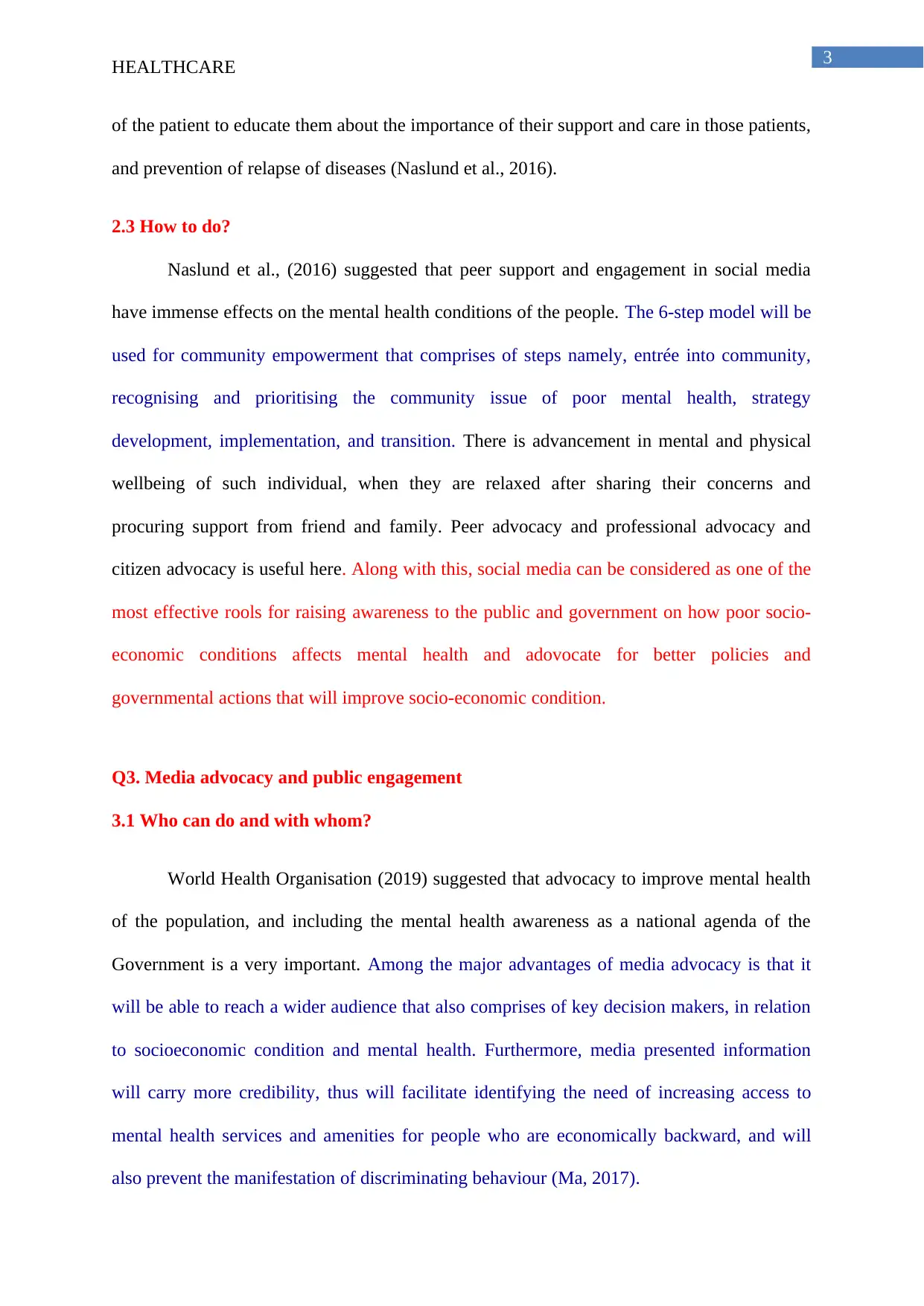
3
HEALTHCARE
of the patient to educate them about the importance of their support and care in those patients,
and prevention of relapse of diseases (Naslund et al., 2016).
2.3 How to do?
Naslund et al., (2016) suggested that peer support and engagement in social media
have immense effects on the mental health conditions of the people. The 6-step model will be
used for community empowerment that comprises of steps namely, entrée into community,
recognising and prioritising the community issue of poor mental health, strategy
development, implementation, and transition. There is advancement in mental and physical
wellbeing of such individual, when they are relaxed after sharing their concerns and
procuring support from friend and family. Peer advocacy and professional advocacy and
citizen advocacy is useful here. Along with this, social media can be considered as one of the
most effective rools for raising awareness to the public and government on how poor socio-
economic conditions affects mental health and adovocate for better policies and
governmental actions that will improve socio-economic condition.
Q3. Media advocacy and public engagement
3.1 Who can do and with whom?
World Health Organisation (2019) suggested that advocacy to improve mental health
of the population, and including the mental health awareness as a national agenda of the
Government is a very important. Among the major advantages of media advocacy is that it
will be able to reach a wider audience that also comprises of key decision makers, in relation
to socioeconomic condition and mental health. Furthermore, media presented information
will carry more credibility, thus will facilitate identifying the need of increasing access to
mental health services and amenities for people who are economically backward, and will
also prevent the manifestation of discriminating behaviour (Ma, 2017).
HEALTHCARE
of the patient to educate them about the importance of their support and care in those patients,
and prevention of relapse of diseases (Naslund et al., 2016).
2.3 How to do?
Naslund et al., (2016) suggested that peer support and engagement in social media
have immense effects on the mental health conditions of the people. The 6-step model will be
used for community empowerment that comprises of steps namely, entrée into community,
recognising and prioritising the community issue of poor mental health, strategy
development, implementation, and transition. There is advancement in mental and physical
wellbeing of such individual, when they are relaxed after sharing their concerns and
procuring support from friend and family. Peer advocacy and professional advocacy and
citizen advocacy is useful here. Along with this, social media can be considered as one of the
most effective rools for raising awareness to the public and government on how poor socio-
economic conditions affects mental health and adovocate for better policies and
governmental actions that will improve socio-economic condition.
Q3. Media advocacy and public engagement
3.1 Who can do and with whom?
World Health Organisation (2019) suggested that advocacy to improve mental health
of the population, and including the mental health awareness as a national agenda of the
Government is a very important. Among the major advantages of media advocacy is that it
will be able to reach a wider audience that also comprises of key decision makers, in relation
to socioeconomic condition and mental health. Furthermore, media presented information
will carry more credibility, thus will facilitate identifying the need of increasing access to
mental health services and amenities for people who are economically backward, and will
also prevent the manifestation of discriminating behaviour (Ma, 2017).
Paraphrase This Document
Need a fresh take? Get an instant paraphrase of this document with our AI Paraphraser
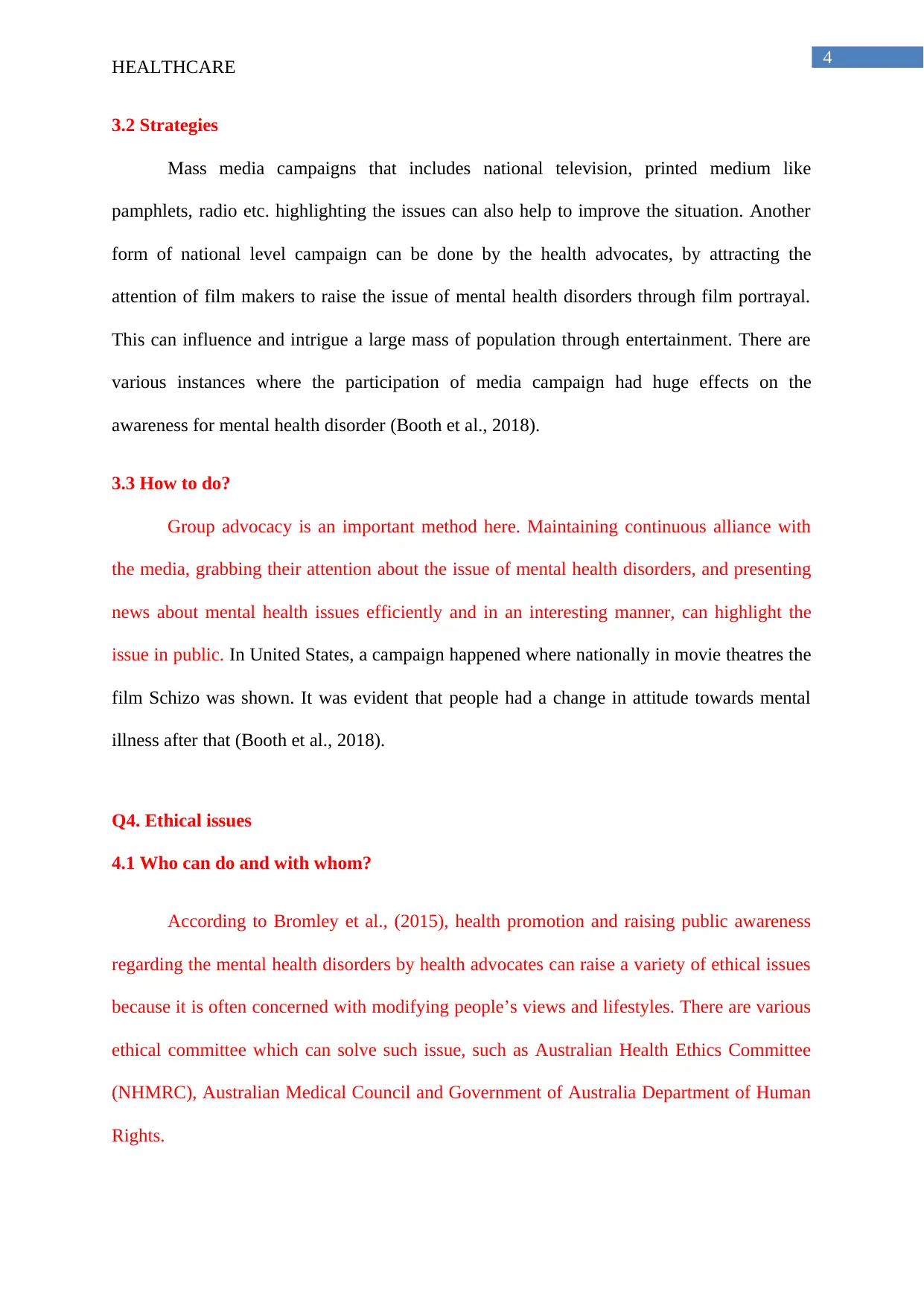
4
HEALTHCARE
3.2 Strategies
Mass media campaigns that includes national television, printed medium like
pamphlets, radio etc. highlighting the issues can also help to improve the situation. Another
form of national level campaign can be done by the health advocates, by attracting the
attention of film makers to raise the issue of mental health disorders through film portrayal.
This can influence and intrigue a large mass of population through entertainment. There are
various instances where the participation of media campaign had huge effects on the
awareness for mental health disorder (Booth et al., 2018).
3.3 How to do?
Group advocacy is an important method here. Maintaining continuous alliance with
the media, grabbing their attention about the issue of mental health disorders, and presenting
news about mental health issues efficiently and in an interesting manner, can highlight the
issue in public. In United States, a campaign happened where nationally in movie theatres the
film Schizo was shown. It was evident that people had a change in attitude towards mental
illness after that (Booth et al., 2018).
Q4. Ethical issues
4.1 Who can do and with whom?
According to Bromley et al., (2015), health promotion and raising public awareness
regarding the mental health disorders by health advocates can raise a variety of ethical issues
because it is often concerned with modifying people’s views and lifestyles. There are various
ethical committee which can solve such issue, such as Australian Health Ethics Committee
(NHMRC), Australian Medical Council and Government of Australia Department of Human
Rights.
HEALTHCARE
3.2 Strategies
Mass media campaigns that includes national television, printed medium like
pamphlets, radio etc. highlighting the issues can also help to improve the situation. Another
form of national level campaign can be done by the health advocates, by attracting the
attention of film makers to raise the issue of mental health disorders through film portrayal.
This can influence and intrigue a large mass of population through entertainment. There are
various instances where the participation of media campaign had huge effects on the
awareness for mental health disorder (Booth et al., 2018).
3.3 How to do?
Group advocacy is an important method here. Maintaining continuous alliance with
the media, grabbing their attention about the issue of mental health disorders, and presenting
news about mental health issues efficiently and in an interesting manner, can highlight the
issue in public. In United States, a campaign happened where nationally in movie theatres the
film Schizo was shown. It was evident that people had a change in attitude towards mental
illness after that (Booth et al., 2018).
Q4. Ethical issues
4.1 Who can do and with whom?
According to Bromley et al., (2015), health promotion and raising public awareness
regarding the mental health disorders by health advocates can raise a variety of ethical issues
because it is often concerned with modifying people’s views and lifestyles. There are various
ethical committee which can solve such issue, such as Australian Health Ethics Committee
(NHMRC), Australian Medical Council and Government of Australia Department of Human
Rights.
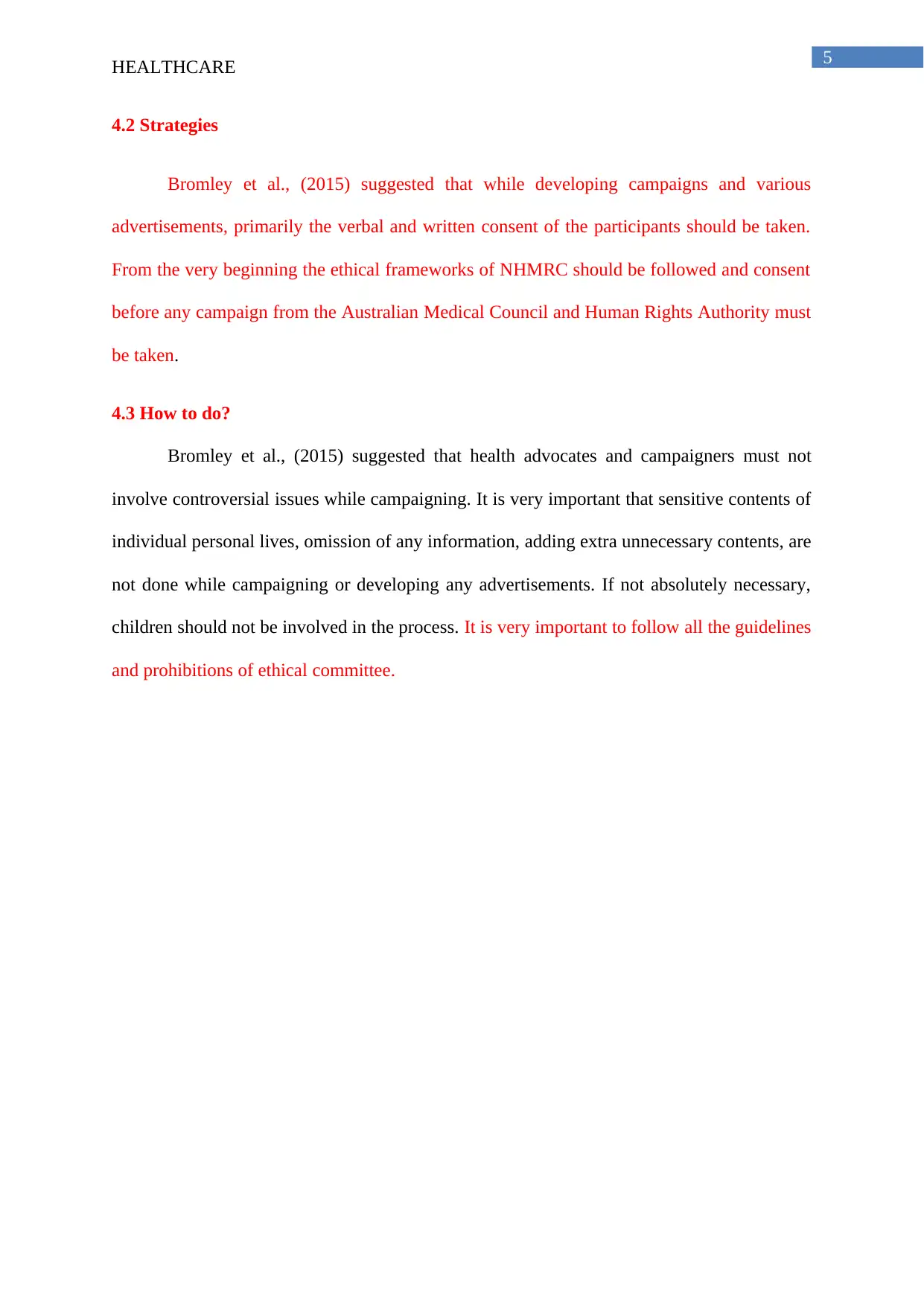
5
HEALTHCARE
4.2 Strategies
Bromley et al., (2015) suggested that while developing campaigns and various
advertisements, primarily the verbal and written consent of the participants should be taken.
From the very beginning the ethical frameworks of NHMRC should be followed and consent
before any campaign from the Australian Medical Council and Human Rights Authority must
be taken.
4.3 How to do?
Bromley et al., (2015) suggested that health advocates and campaigners must not
involve controversial issues while campaigning. It is very important that sensitive contents of
individual personal lives, omission of any information, adding extra unnecessary contents, are
not done while campaigning or developing any advertisements. If not absolutely necessary,
children should not be involved in the process. It is very important to follow all the guidelines
and prohibitions of ethical committee.
HEALTHCARE
4.2 Strategies
Bromley et al., (2015) suggested that while developing campaigns and various
advertisements, primarily the verbal and written consent of the participants should be taken.
From the very beginning the ethical frameworks of NHMRC should be followed and consent
before any campaign from the Australian Medical Council and Human Rights Authority must
be taken.
4.3 How to do?
Bromley et al., (2015) suggested that health advocates and campaigners must not
involve controversial issues while campaigning. It is very important that sensitive contents of
individual personal lives, omission of any information, adding extra unnecessary contents, are
not done while campaigning or developing any advertisements. If not absolutely necessary,
children should not be involved in the process. It is very important to follow all the guidelines
and prohibitions of ethical committee.
⊘ This is a preview!⊘
Do you want full access?
Subscribe today to unlock all pages.

Trusted by 1+ million students worldwide
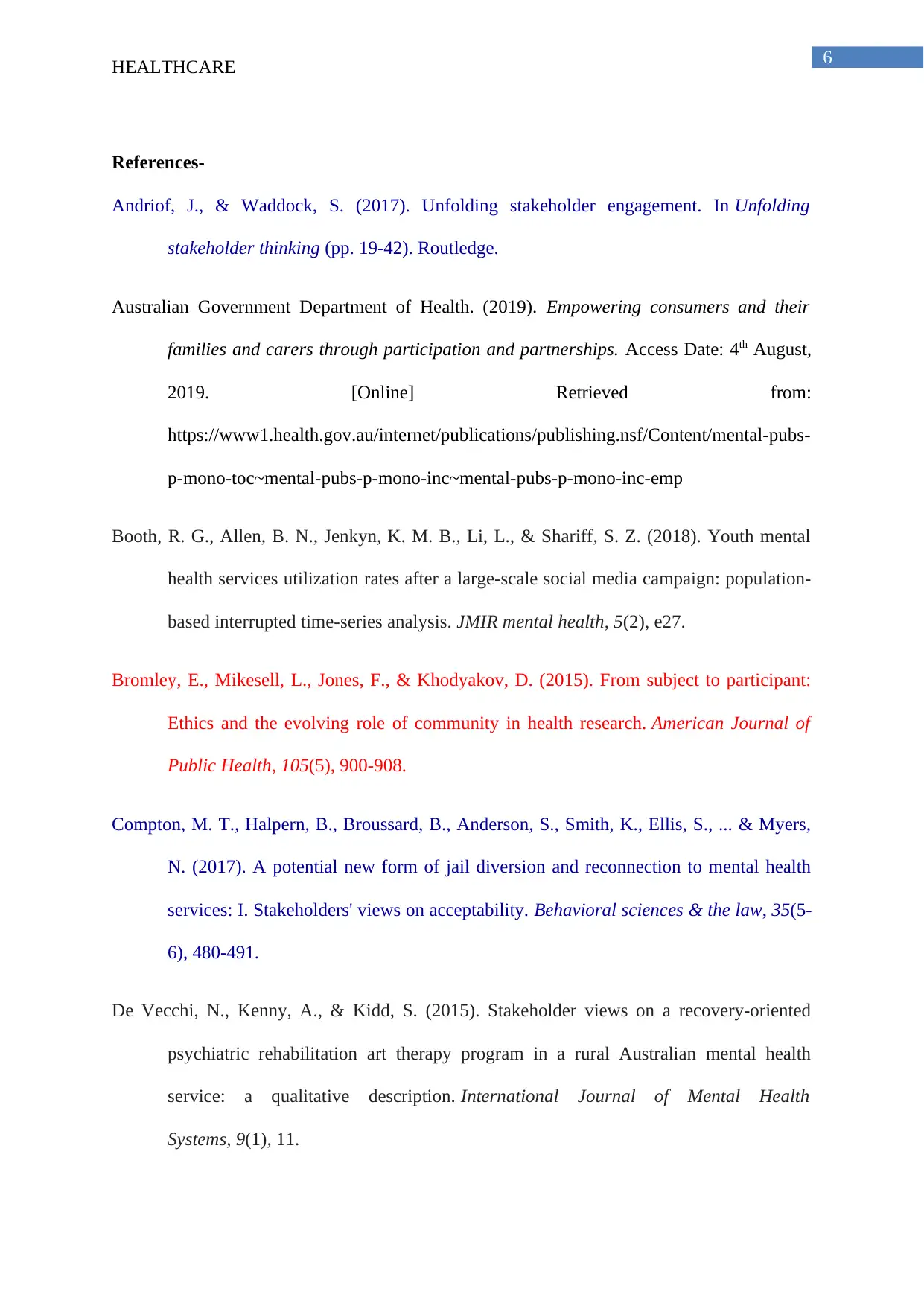
6
HEALTHCARE
References-
Andriof, J., & Waddock, S. (2017). Unfolding stakeholder engagement. In Unfolding
stakeholder thinking (pp. 19-42). Routledge.
Australian Government Department of Health. (2019). Empowering consumers and their
families and carers through participation and partnerships. Access Date: 4th August,
2019. [Online] Retrieved from:
https://www1.health.gov.au/internet/publications/publishing.nsf/Content/mental-pubs-
p-mono-toc~mental-pubs-p-mono-inc~mental-pubs-p-mono-inc-emp
Booth, R. G., Allen, B. N., Jenkyn, K. M. B., Li, L., & Shariff, S. Z. (2018). Youth mental
health services utilization rates after a large-scale social media campaign: population-
based interrupted time-series analysis. JMIR mental health, 5(2), e27.
Bromley, E., Mikesell, L., Jones, F., & Khodyakov, D. (2015). From subject to participant:
Ethics and the evolving role of community in health research. American Journal of
Public Health, 105(5), 900-908.
Compton, M. T., Halpern, B., Broussard, B., Anderson, S., Smith, K., Ellis, S., ... & Myers,
N. (2017). A potential new form of jail diversion and reconnection to mental health
services: I. Stakeholders' views on acceptability. Behavioral sciences & the law, 35(5-
6), 480-491.
De Vecchi, N., Kenny, A., & Kidd, S. (2015). Stakeholder views on a recovery-oriented
psychiatric rehabilitation art therapy program in a rural Australian mental health
service: a qualitative description. International Journal of Mental Health
Systems, 9(1), 11.
HEALTHCARE
References-
Andriof, J., & Waddock, S. (2017). Unfolding stakeholder engagement. In Unfolding
stakeholder thinking (pp. 19-42). Routledge.
Australian Government Department of Health. (2019). Empowering consumers and their
families and carers through participation and partnerships. Access Date: 4th August,
2019. [Online] Retrieved from:
https://www1.health.gov.au/internet/publications/publishing.nsf/Content/mental-pubs-
p-mono-toc~mental-pubs-p-mono-inc~mental-pubs-p-mono-inc-emp
Booth, R. G., Allen, B. N., Jenkyn, K. M. B., Li, L., & Shariff, S. Z. (2018). Youth mental
health services utilization rates after a large-scale social media campaign: population-
based interrupted time-series analysis. JMIR mental health, 5(2), e27.
Bromley, E., Mikesell, L., Jones, F., & Khodyakov, D. (2015). From subject to participant:
Ethics and the evolving role of community in health research. American Journal of
Public Health, 105(5), 900-908.
Compton, M. T., Halpern, B., Broussard, B., Anderson, S., Smith, K., Ellis, S., ... & Myers,
N. (2017). A potential new form of jail diversion and reconnection to mental health
services: I. Stakeholders' views on acceptability. Behavioral sciences & the law, 35(5-
6), 480-491.
De Vecchi, N., Kenny, A., & Kidd, S. (2015). Stakeholder views on a recovery-oriented
psychiatric rehabilitation art therapy program in a rural Australian mental health
service: a qualitative description. International Journal of Mental Health
Systems, 9(1), 11.
Paraphrase This Document
Need a fresh take? Get an instant paraphrase of this document with our AI Paraphraser
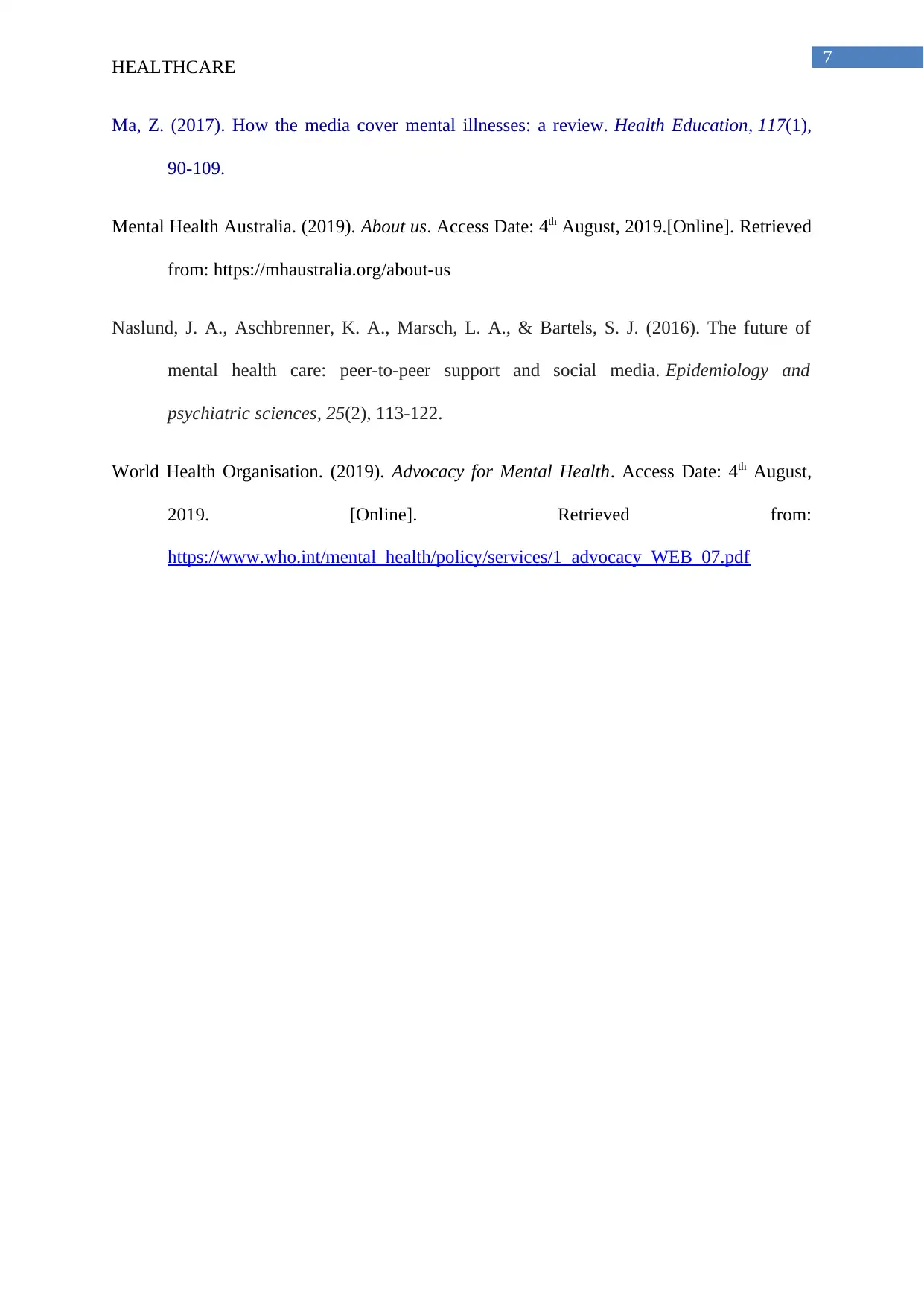
7
HEALTHCARE
Ma, Z. (2017). How the media cover mental illnesses: a review. Health Education, 117(1),
90-109.
Mental Health Australia. (2019). About us. Access Date: 4th August, 2019.[Online]. Retrieved
from: https://mhaustralia.org/about-us
Naslund, J. A., Aschbrenner, K. A., Marsch, L. A., & Bartels, S. J. (2016). The future of
mental health care: peer-to-peer support and social media. Epidemiology and
psychiatric sciences, 25(2), 113-122.
World Health Organisation. (2019). Advocacy for Mental Health. Access Date: 4th August,
2019. [Online]. Retrieved from:
https://www.who.int/mental_health/policy/services/1_advocacy_WEB_07.pdf
HEALTHCARE
Ma, Z. (2017). How the media cover mental illnesses: a review. Health Education, 117(1),
90-109.
Mental Health Australia. (2019). About us. Access Date: 4th August, 2019.[Online]. Retrieved
from: https://mhaustralia.org/about-us
Naslund, J. A., Aschbrenner, K. A., Marsch, L. A., & Bartels, S. J. (2016). The future of
mental health care: peer-to-peer support and social media. Epidemiology and
psychiatric sciences, 25(2), 113-122.
World Health Organisation. (2019). Advocacy for Mental Health. Access Date: 4th August,
2019. [Online]. Retrieved from:
https://www.who.int/mental_health/policy/services/1_advocacy_WEB_07.pdf
1 out of 8
Related Documents
Your All-in-One AI-Powered Toolkit for Academic Success.
+13062052269
info@desklib.com
Available 24*7 on WhatsApp / Email
![[object Object]](/_next/static/media/star-bottom.7253800d.svg)
Unlock your academic potential
Copyright © 2020–2025 A2Z Services. All Rights Reserved. Developed and managed by ZUCOL.





